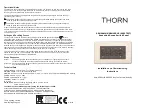
Master/Slave Functionality
A mainframe can only hold up to five modules, so for more complex setups a second mainframe is
required. The BIT-2100B allows you to connect one mainframe (the “master”) to your computer as
usual, and connect another mainframe (the “slave”) to the master mainframe via USB, which allows
you to control the relays of both mainframes with only one remote connection:
•
connect both instruments to AC power
•
connect the instrument you want to use as a master to your PC as usual
◦
you can use USB or LAN; see next sections
•
connect the two instruments using a USB A-to-B cable:
◦
use the type B (rectangular) connector on the master instrument
◦
use the type A (square shaped) connector on the slave instrument
Such a connection is shown in figure 3.
In this setup, even though your computer is only connected to the master mainframe, the relays in
the slave frame can be controlled via the remote commands (page 23) sent to the master mainframe.
The master/slave feature focuses on relay control, not the entire functionality; it is explicitly noted in
this manual when a software feature includes slave mainframes.
Connecting more than one slave to a master, or daisy-chaining multiple slaves, is
not
supported.
It is
not
recommended to establish another VISA connection via LAN to the slave while it is in a
master/slave configuration, as it might interfere with the communication between the master and
the slave.
The current status of the master/slave configuration is also shown on the display, see page 11.
BIT-2100B User Manual
13
Figure 3: How to connect a master/slave configuration














































